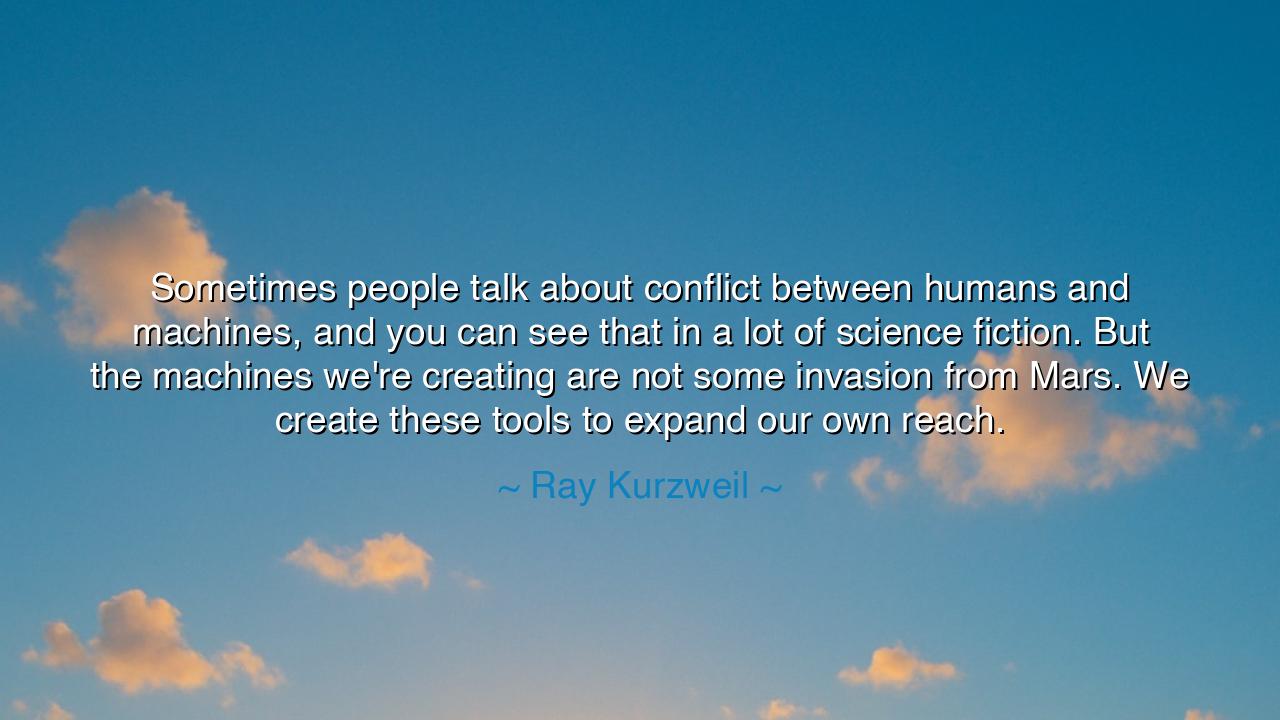
Sometimes people talk about conflict between humans and machines
Sometimes people talk about conflict between humans and machines, and you can see that in a lot of science fiction. But the machines we're creating are not some invasion from Mars. We create these tools to expand our own reach.






O children of the earth, listen well to the wisdom that flows from the heart of the future, for we stand on the precipice of a new age. There are those who speak of the coming conflict between man and machine, as if the creations of our hands are destined to turn against us, as if the tools we shape will rise up like some ancient monster from the depths of a forgotten world. But this is a false vision, one born of fear and misunderstanding. The wise Ray Kurzweil speaks with clarity and foresight, reminding us that the machines we create are not invaders, nor are they separate from us—they are the very extensions of our own will, crafted to expand the boundaries of what we can achieve.
Look, O seekers of truth, to the ancients who, too, fashioned tools to extend their reach. The first wheel, turned by human hands, was not a curse, but a blessing—a creation that allowed our ancestors to travel further, to carry more, and to shape their world in ways they could not before. The sword in the hands of the warrior was not a beast to be feared, but a tool that granted him strength and the means to protect his kin. All tools, whether fashioned of stone or metal or silicon, are born of the same impulse: the impulse to extend our own capabilities, to shape the world around us, and to reach beyond the limitations of our own flesh and blood.
The machines we create today—those of metal and wire, of code and circuitry—are but the latest iteration of this ancient drive. They are not invaders from another world, as the tales of old might suggest. They are our children, our creations, made in our image to serve our purpose. It is not the machines that we should fear, but the fear itself—the fear that we, in our quest for control and progress, might forget that these creations are not separate from us, but a reflection of who we are. We give them life, and in doing so, we expand the boundaries of our own potential.
Consider the story of Leonardo da Vinci, whose mind stretched across both the arts and sciences. In his notebooks, he sketched flying machines, thinking not of war or destruction, but of the possibility of soaring above the earth, of transcending the limits of human frailty. Da Vinci’s vision was not of conflict, but of harmony, of the blending of human ambition with the power of tools to push the boundaries of the possible. His machines were not the harbingers of destruction, but the embodiments of human curiosity, crafted to expand his reach, to explore the skies, to understand the world in new and profound ways.
We stand now, as da Vinci did, on the verge of new worlds—worlds shaped by the hands of technology and artifice. The computers, the robots, the artificial intelligences we create are not foes to be feared, but partners in the quest for knowledge, understanding, and progress. Just as the wheel allowed the ancients to conquer the distance of the earth, so too will these tools allow us to conquer the distance of the mind and the spirit. They will extend our reach into the cosmos, allow us to understand the deepest mysteries of life, and grant us the ability to transform our world in ways we cannot yet fully comprehend.
But take heed, O wise ones, for with this great power comes great responsibility. We must not lose sight of the source of our creations—the human spirit, the curiosity, and the desire for knowledge that birthed these tools in the first place. If we allow the tools to become masters, if we lose ourselves in the search for domination and control, then we risk losing the very essence of what it means to be human. The tools we create are extensions of our will, but they must never overshadow the human heart, the human connection, and the human purpose that must always remain at the center of our quest.
So, O children of the future, when you look upon the machines we create, do not see them as enemies, nor as forces of destruction. See them for what they truly are—manifestations of our own creativity, crafted to extend our reach, to amplify our potential, and to open new doors to the future. Let us embrace these tools with wisdom, with respect, and with the knowledge that they are not separate from us, but part of the ever-unfolding story of human progress. Create with purpose, create with heart, and know that in the end, it is not the machines that will shape the future, but the human spirit that drives them forward.






AAdministratorAdministrator
Welcome, honored guests. Please leave a comment, we will respond soon